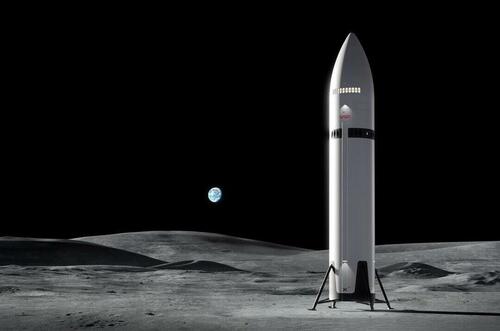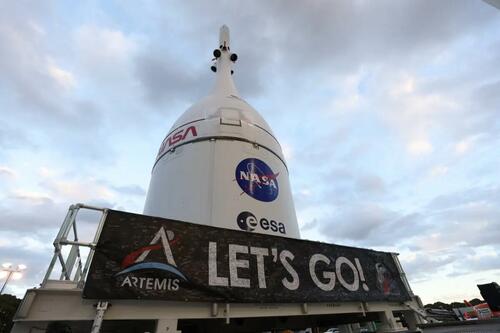Musk Responds After SpaceX Loses Guarantee Of First Moon Landing
Up until Oct. 20, the return of NASA astronauts to the lunar surface was set to be carried out by a variant of SpaceX’s Starship upper stage.
Now, according to Acting Administrator of NASA Sean Duffy, that may not be the case.
Elon Musk’s behemoth rocket still has not conducted a successful mission into low Earth orbit, sparking some doubt about whether or not its human landing spacecraft would be ready in time for Artemis III, a planned moon landing, in 2027.
To ensure American boots return to the lunar surface by then – and, most importantly, before communist China – Duffy officially opened the lunar lander opportunity to SpaceX competitors.
“We are in a race against China so we need the best companies to operate at a speed that gets us to the Moon FIRST,” Duffy said on X.
“SpaceX has the contract to build the [Human Landing System] which will get U.S. astronauts there on Artemis III. But, competition and innovation are the keys to our dominance in space so @NASA is opening up HLS production to Blue Origin and other great American companies.”
We are in a race against China so we need the best companies to operate at a speed that gets us to the Moon FIRST.
SpaceX has the contract to build the HLS which will get U.S. astronauts there on Artemis III.
But, competition and innovation are the keys to our dominance in… pic.twitter.com/dAo0so5qqZ
— NASA Acting Administrator Sean Duffy (@SecDuffyNASA) October 20, 2025
As T.J.Muscaro reports below for The Epoch Times, NASA already planned to utilize landing spacecraft from multiple spacefaring companies, including Blue Origin’s Blue Moon Mark 1 lander, but SpaceX won the contract to provide the first lander.
Duffy did not say the contract to provide a lander was canceled, but rather that SpaceX was no longer the guaranteed choice for Artemis III.
Musk rebuked the idea that his company would not make the deadline in time.
“SpaceX is moving like lightning compared to the rest of the space industry,” Musk said on X in direct response to Duffy.
“Moreover, Starship will end up doing the whole Moon mission. Mark my words.”
They won’t. SpaceX is moving like lightning compared to the rest of the space industry.
Moreover, Starship will end up doing the whole Moon mission. Mark my words.
— Elon Musk (@elonmusk) October 20, 2025
Duffy responded positively to Musk’s statement, affirming that the Starship variant could still be the chosen lander.
“Love the passion. The race to the Moon is ON,” he said.
“Great companies shouldn’t be afraid of a challenge. When our innovators compete with each other, America wins.”
Artemis II Fully Stacked
Meanwhile, the rocket assigned to the Artemis II mission in 2026—the first to carry human beings on a trip around the moon in more than 50 years—was completely assembled on Oct. 20.
Artemis II’s Orion crew capsule Integrity and service module is moved to be stacked on top of the Space Launch System, at the vehicle assembly building at the Kennedy Space Center in Florida on Oct. 17. (Acting NASA Administrator Sean Duffy).
NASA’s Orion crew capsule, named “Integrity,” and its service module were fitted with their launch abort system and transported to the Vehicle Assembly Building at the Kennedy Space Center in Florida on Oct. 17.
Three days later, the suite of human spaceflight systems was lifted into place on top of the behemoth rocket dubbed the Space Launch System.
Duffy shared the updates to NASA’s moon program on X, despite the federal government shutdown and the space program’s resulting media blackout.
“The last major hardware component before Artemis II launches early next year has been installed,” Duffy said on X.
“‘Integrity’ is our Orion spacecraft that will hold the Artemis II astronauts on their trip around the Moon. It’s now fully attached to the Space Launch System, and we are one step closer to mission launch!”
Beneath Integrity is a rocket more powerful than Saturn V, the last rocket to take human beings to the moon during the Apollo program. Flanked by two massive solid boosters reminiscent of the Space Shuttle era, the rocket consists of two stages: the first, which will produce 8.8 million pounds of thrust to lift the Artemis II crew off the pad, and the second, which will put Integrity into orbit and, on later missions, send astronauts to the moon.
Artemis II is slated to launch in February 2026, crewed by NASA Astronauts Victor Glover, Christina Koch, and Reid Wiseman, as well as Canadian Astronaut Jeremy Hansen. However, this mission will not return human beings to the surface of the moon.
Duffy said that progress to that launch would continue despite the government shutdown.
“We’ve worked closely with President Trump to ensure the shutdown won’t slow down America’s return to the Moon,” Duffy said on X.
“But many of NASA’s best and brightest are working without pay because of the Democrats’ shutdown. It’s time for Democrats to stop jeopardizing American space dominance and reopen the government.”
Tyler Durden
Wed, 10/22/2025 – 14:10ZeroHedge NewsRead More







 T1
T1


